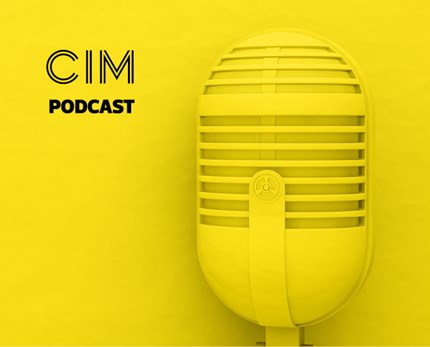A day in the life: Brand marketing executive

- 22 April 2021
Ever wondered if you've got what it takes to make it in marketing? Find out in this article from Elliot, a brand marketing executive in the Brand and Communications team at the Chartered Institute of Marketing (CIM)
I didn’t go straight into marketing after school. I actually did a sales apprenticeship when I was eighteen in the motor trade, but after a couple of years of selling cars, I decided that it wasn’t for me long-term. I went to university and, not being sure what I wanted to study, opted for Business Studies and Management as a practical choice. I really loved the mandatory marketing module, so I chose marketing for every possible elective and, by the time that I graduated, I was certain that it was what I wanted to do.
I joined CIM, soon after graduating, as a coordinator in the Brand and Communications team. As a coordinator, you contribute heavily to tactical activity, such as briefing the Creative team for campaign imagery and securing customer testimonials. In addition, I was open to getting involved with any other team activity I could in order to learn on the job. Sensing this, my manager put me on some small level campaigns, and I relished the chance to use some of the theory I learnt in my degree and apply it to real world activity with a budget.
I was later promoted to brand marketing executive, in charge of a number of campaigns that promote CIM’s brand. Although no day is truly the same, in this article I’ll take you through what I get up to in a day as CIM’s brand marketing executive.
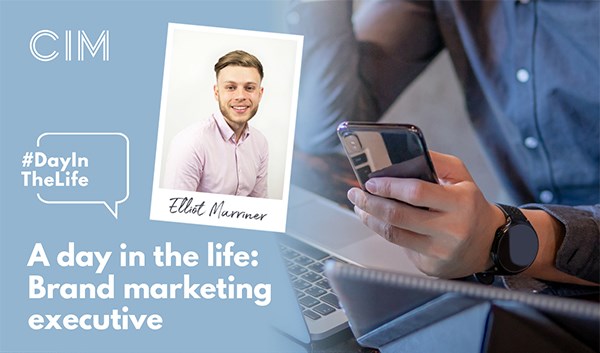
09:00 – Know your figures
As a brand marketing executive, you often have a few campaigns running simultaneously, so the first thing I do each morning is monitor campaign performance, which means checking how each campaign is performing against its key performance indicators (KPIs). KPIs can be any number of things – from people clicking on a URL to filling out a form – but it’s important to think about them as an indication of how your campaign is performing at each moment in time.
This means opening Google Analytics, a tool that tracks and reports on digital performance, to see how our campaigns are doing. Throughout any campaign, I will have regular meetings with the Channel team to get the insights behind the data, but it’s important that I know the headline numbers of how the projects are performing so that we can make changes as needed.
On a practical level, a brand marketing executive has a lot of stakeholders to manage. We are always reporting back to relevant departments around the business, such as the Membership or the Partnerships team, as well as senior management, so having the figures is vital. Apart from that you have to justify each action on a budgetary level on whether or not it is performing and adjust your spend as required.
10:00 – Building a timings plan
I’m currently running a campaign to promote CIM’s Professional Marketing Qualifications, so I’m working on a timings plan for when we need each action to be performed. This means briefing people internally; in other words, making sure that each team has enough time to perform their part of the campaign development process. A timings plan is about mapping out the whole campaign process, making sure that each marketing stakeholder has agreed to the schedule. Sometimes, it’s also about me putting in enough time for the tasks that I have to do; it’s about your own personal schedule as well, not just those of your colleagues.
This involves creating a Gantt chart in Microsoft Excel, one that we can all reference and check in on with ever-changing timings and priorities, which might look something like the below.
11:30 – Monitor your competitors
Any brand marketing executive should be aware of the competition. CIM partners with many organisations, including Accredited Study Centres, universities, and other professional bodies, but we do look to other marketing bodies or qualifications providers, for competitor analysis. The pandemic has been a time of change, and studying the competition, through reports or social media monitoring, can help us to understand our own brand relevance.
I also look at what the wider marketing community is saying about CIM. That means engaging in activities such as social listening with the Channel team to find out what our members, recruiters, and the marketing community think about us; they are all part of our brand identity and you need to be aware of your reputation in the market. If you have an inflated perception of your brand, you won’t know the value of your products.
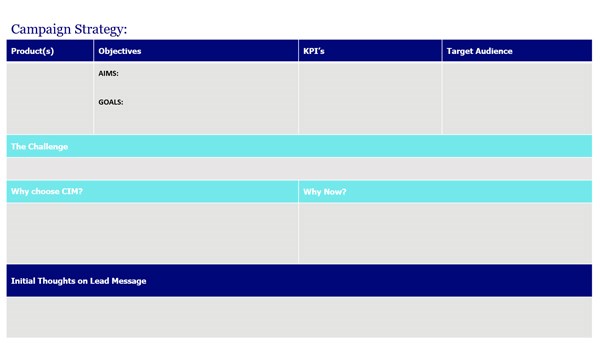

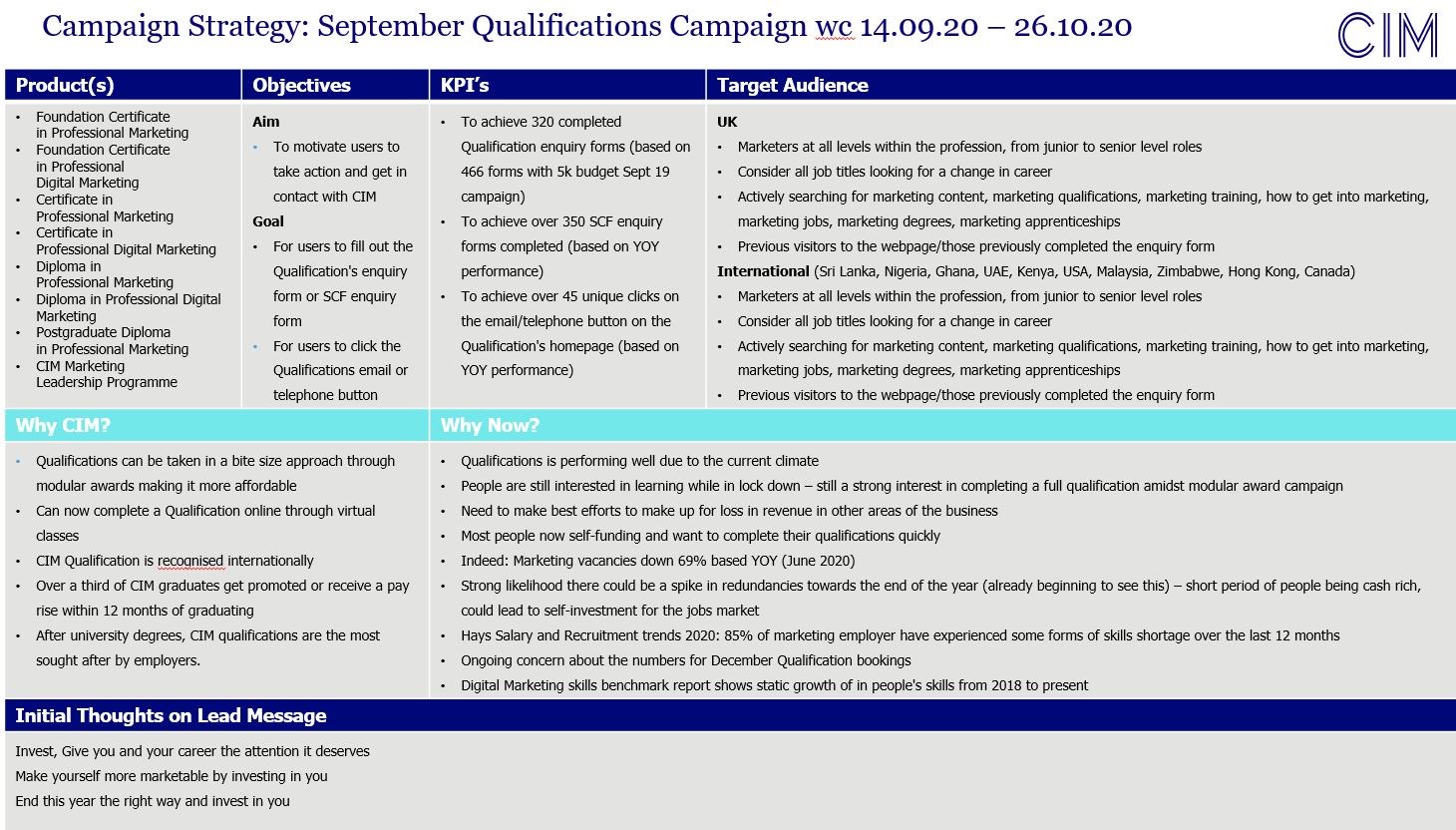 12:00 — Let’s get strategic
12:00 — Let’s get strategic
At CIM, we create strategy documents (based on the template above) to help set the vision for our campaigns. These one-page PowerPoint documents provide the aim of the campaign, the target audience, consumer insight and ideas on lead messaging behind each campaign, helping ensure internal buy-in and providing a framework for everybody to work towards.
This afternoon, I am preparing the strategy document for a campaign to help promote our qualifications.
I start by setting out the product, aim, goals, and Key Performance Indicators (KPIs) for measurement. Then I determine the target audience, which in this case is very broad because qualifications can be applicable to a wide range of marketers, business professionals, and people looking to change career.
Other key parts of this document include clarifying what challenge the campaign will be looking to overcome or address, as well as the key messages of the campaign, and the channels we’ll use to deliver those messages.
Though this document looks simple, it requires a lot of research from understanding the latest digital behaviours from our Channel team, to discussing customer feedback with the Customer Experience team, to talking with Partnerships, to looking at how other campaigns performed. All of this information is needed before I even write a word of the document.
14:00 – An afternoon of meetings
As a brand marketing executive, you never work on just one thing at once. This afternoon I am optimising the webpage for our Graduate Gateway programme. Graduate Gateway is a programme that allows students modular exemptions from CIM’s Professional Marketing Qualifications if they have a degree from an accredited university.
For this, I am taking a look at activity on the webpage – time spent on it, where users click once on the page according to our heatmaps – so I can take insights on how the page is performing and apply it to our new plan. A project such as this requires multiple internal teams, from pulling the research available from the Partnerships team, to the insight and analysis provided by the Channel team, as well as the Creative influence to make it look more engaging.
Working effectively with non-marketing teams means taking their knowledge and insight and packaging it up in a digestible way that helps promote the product and the brand, in a way that will resonate with the target audience. This means regular meetings to ensure the project is on track and aligned with everyone’s expectations.

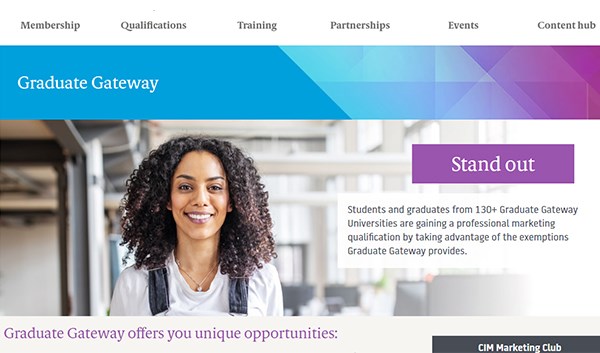
16:45 – Keep them updated
I spend the last fifteen minutes of the day updating our team’s status report, which is a document detailing how our key tasks are progressing. This is not just a bit of admin at the end of the day, it’s a vital source of getting an overall view of the team’s workflow. It’s not fun but it’s vital; nobody wants to spend too much time looking for answers, we need clear and precise information on key projects to hand, and this is our way of getting it.
What does it take to be a brand marketing executive?
To be a brand marketing executive, you need to be a people person who is comfortable with a lot of communication. I still use a lot of my sales skills to manage stakeholders and, though I wouldn’t rule out introverted people taking on this role, outgoing and organised people may fair best, especially in a virtual environment, because it involves being proactive and managing expectations.
When you’re dealing with brand, you have to be adept with communicating using numbers, words, and imagery. You don’t have to be extremely detailed with all three, but you need to have some comfort with each of them in order to bounce ideas around.
Most of all, you have to be resilient. Any brand has a lot of guidelines and a number of stakeholders requiring careful management. Ultimately, you have to be agile with your thinking because, believe me, plans can change quickly. Putting theory into practice is a great way of adapting to working life, but the real world throws a few curveballs too. The best thing to do as a marketer, particularly one dealing with brand, is get stuck in, and always be willing to learn, because every day throws up a new challenge, which budding marketers need to be prepared for.
Are you a people person with one eye on the brand guidelines? Whatever your personality, marketing could have the role for you. Find yours by clicking on our Get into Marketing page today.

- 0 views

 FAQs
FAQs
 Log in
Log in
 MyCIM
MyCIM




